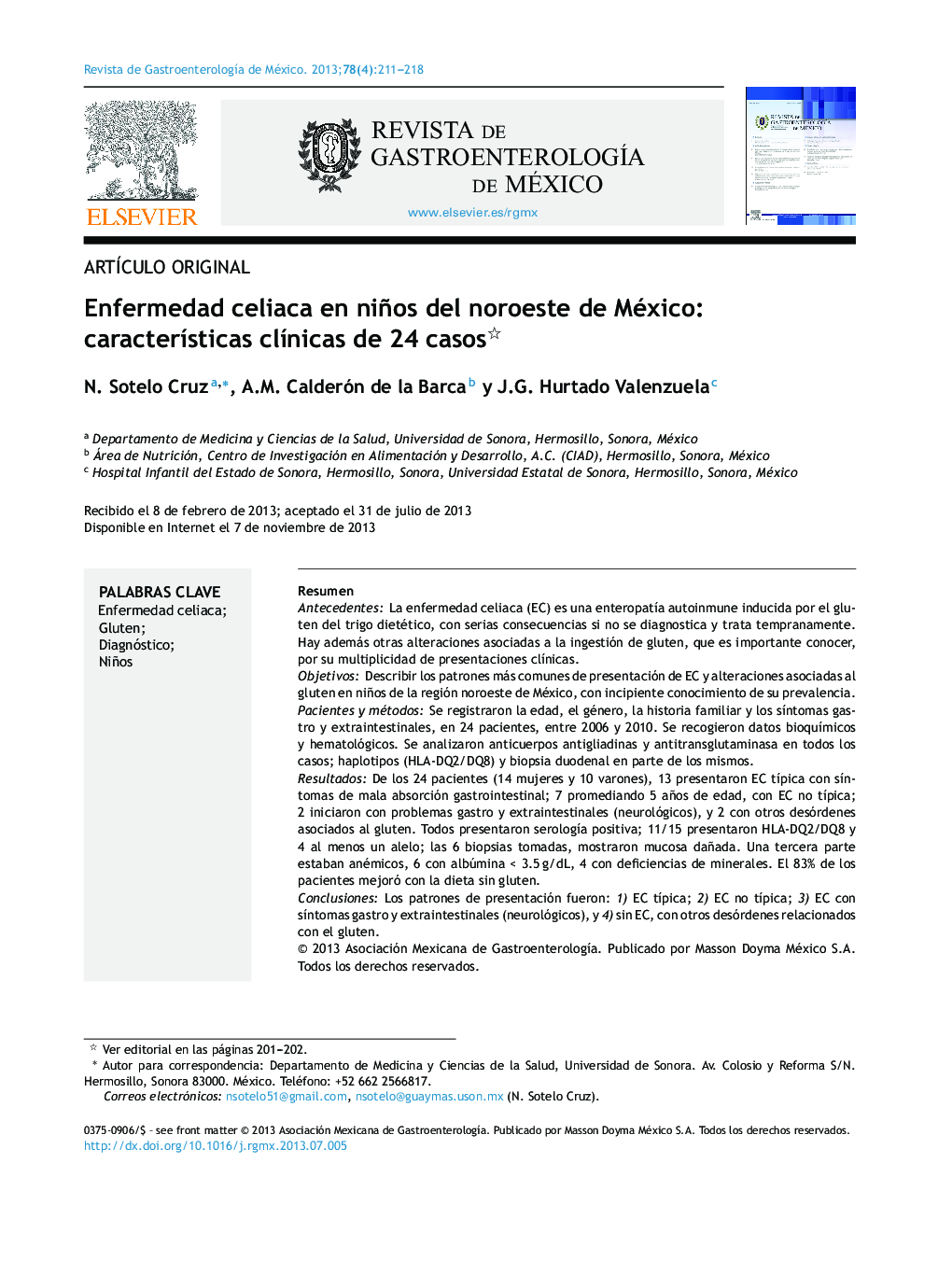| Article ID | Journal | Published Year | Pages | File Type |
|---|---|---|---|---|
| 3318812 | Revista de Gastroenterología de México | 2013 | 8 Pages |
ResumenAntecedentesLa enfermedad celiaca (EC) es una enteropatía autoinmune inducida por el gluten del trigo dietético, con serias consecuencias si no se diagnostica y trata tempranamente. Hay además otras alteraciones asociadas a la ingestión de gluten, que es importante conocer, por su multiplicidad de presentaciones clínicas.ObjetivosDescribir los patrones más comunes de presentación de EC y alteraciones asociadas al gluten en niños de la región noroeste de México, con incipiente conocimiento de su prevalencia.Pacientes y métodosSe registraron la edad, el género, la historia familiar y los síntomas gastro y extraintestinales, en 24 pacientes, entre 2006 y 2010. Se recogieron datos bioquímicos y hematológicos. Se analizaron anticuerpos antigliadinas y antitransglutaminasa en todos los casos; haplotipos (HLA-DQ2/DQ8) y biopsia duodenal en parte de los mismos.ResultadosDe los 24 pacientes (14 mujeres y 10 varones), 13 presentaron EC típica con síntomas de mala absorción gastrointestinal; 7 promediando 5 años de edad, con EC no típica; 2 iniciaron con problemas gastro y extraintestinales (neurológicos), y 2 con otros desórdenes asociados al gluten. Todos presentaron serología positiva; 11/15 presentaron HLA-DQ2/DQ8 y 4 al menos un alelo; las 6 biopsias tomadas, mostraron mucosa dañada. Una tercera parte estaban anémicos, 6 con albúmina < 3.5 g/dL, 4 con deficiencias de minerales. El 83% de los pacientes mejoró con la dieta sin gluten.ConclusionesLos patrones de presentación fueron: 1) EC típica; 2) EC no típica; 3) EC con síntomas gastro y extraintestinales (neurológicos), y 4) sin EC, con otros desórdenes relacionados con el gluten.
BackgroundCeliac disease (CD) is an autoimmune enteropathy induced by dietary wheat gluten that can have serious consequences if not diagnosed and treated early. It is important to be familiar with other alterations associated with gluten ingestion due to the multiplicity of clinical presentations.ObjectivesTo describe the most common CD presentation patterns and alterations associated with gluten in children from the northwest region of Mexico, with an incipient knowledge of its prevalence.Patients and methodsAge, sex, family history, and gastrointestinal and extraintestinal symptoms were recorded in 24 patients within the time frame of 2006 to 2010. Biochemical and hematologic data were collected. Anti-gliadin and anti-transglutaminase antibodies were analyzed in all the cases, and haplotypes (HLA-DQ2/DQ8) and duodenal biopsy were evaluated in some of the cases.ResultsOf the 24 patients (14 girls and 10 boys), 13 presented with typical CD with symptoms of poor gastrointestinal absorption; 7 patients with a mean age of 5 years presented with atypical CD; 2 had disease onset with gastrointestinal and extraintestinal (neurologic) problems; and 2 with other gluten-related disorders. All of the patients had positive serology; 11/15 presented with HLA-DQ2/DQ8 and 4 with at least one allele; damaged mucosa was observed in the 6 biopsies taken. A third of the patients were anemic, 6 presented with an albumin value of < 3.5 g/dL, and 4 with mineral deficiencies. A total of 83% of the patients improved with a gluten-free diet.ConclusionsThe presentation patterns were: 1) typical CD, 2) atypical CD, 3) CD with gastrointestinal and extraintestinal (neurologic) symptoms, and 4) gluten-related disorders other than CD.
